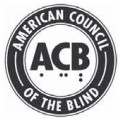 |
 |
|
This month’s features: |
|
Giving Thanks for Our History and Diversity |
A Day In the Life of an Audio Describer |
American Council of The Blind: Description Vocabulary Project |
||

Accessible media to celebrate our history, heroes, and diversity. |

Do you like to play with words and listen with your eyes? |

New DCMP/ACB partnership will help description vendors select grade-appropriate vocabulary. |
Giving Thanks for Our History and Diversity |
||||||||||
This is a great month to celebrate our history, our heroes, and our diversity. November 11th is Veterans Day, November 24th is Thanksgiving Day, and all month we honor Native Americans by commemorating National American Indian Heritage Month. The DCMP has resources to help you create new and unique learning opportunities for your students. Molly's Pilgrim is the story of a young, Russian-Jewish immigrant, who teaches her classmates that Thanksgiving isn't just about turkey and Native Americans. Picture This America: Remembering Those Who Served is a tribute to our military personnel who served in past wars. It highlights several historic monuments which were built to commemorate their service. Comparing the Lives of Native Peoples focuses on how the geography of the land affected and shaped the lives of Native Americans. It includes dramatization of the lives of Native Americans and rare archival photos. Also, check out these DCMP flyers for many more ideas: Related Links
Share This Story
|
Related DCMP Titles |
|||||||||
A Day In the Life of an Audio Describer |
||||||||||
To help readers better understand what description of media is, how it is created, and why it is important to viewers who are blind or visually impaired, the DCMP presents the third in a series of articles written by description company representatives. "If you like to play with words and can listen with your eyes, then you'll enjoy being an audio describer," says Kelly Warren of Mind's Eye Audio Productions. She further defines a quality product by noting that visually impaired viewers like "a voicer with a soft voice who doesn't talk over the narrator. They also prefer clear, short, objective descriptions." Read more to also learn about the Universal Design approach by media producers that ensures that needs of visually impaired persons are "...considered at the conception of the production process." Related LinksShare This Story
|
Related DCMP Resources |
|||||||||
American Council of the Blind: Description Vocabulary Project |
||||||||||
The DCMP has formed a new partnership with the American Council of the Blind (ACB), a national nonprofit organization that strives to increase the independence, security, equality of opportunity, and quality of life for all blind and visually-impaired people. Our objective is to enhance the educational description guidelines, the Description Key, through results of a "STEM Description Vocabulary Project." This project involves developing lists of grade-appropriate vocabulary words to be used in description, with a concentration on STEM content. In 2008, the Description Key was developed by the Described and Captioned Media Program in collaboration with the American Foundation for the Blind. The goal was to provide description vendors and media producers with a framework for ensuring consistency and quality in the description of media for early learners through grade 12+ students who are blind, visually impaired, Also of critical importance is the creation of description vocabulary that is grade-level appropriate. Yet, a constant problem revealed in the review of educational media description is that few description vendors have trained and experienced educators on staff. Most need the assistance that will be generated by the new DCMP/ACB partnership. (Read More). Related LinksShare This Story
|
Related DCMP Resources |
|||||||||
Quick Hits |
||||
Child Safety Protection Month |
National Adoption Awareness Month |
National Emergency Alert System Test |
||

November is Child Safety Protection Month, and DCMP has accessible media resources to support your study. Today children face a variety of dangers. Knowledge is the key to protection. Learn about Bike Safety with Bill Nye the Science Guy, Summer Safety, and Safety for Children: Pedestrian Safety. Protect against bullying with our Stop Bullying flyer. Prevent child abuse with our Child Abuse and Neglect Prevention flyer. We also have Otto the Auto on School Bus Safety, Wise Owl's Drug Safety Kit, and Primary Health & Safety: Germs & Disease. |

Every November, there are activities and celebrations to help build awareness of adoption throughout the nation. DCMP has resources to teach about adoption like: The Adoption Option and Me and My Family (Spanish). We also have media on what family means such as: Family Ties: Strengthening the Family Unit, My Family, Your Family, and That's a Family! Also, check out our Family & Parenting flyer. |

The first ever national test of the Emergency Alert System (EAS) is scheduled for November 9, 2011 at 2:00 p.m. EST. This is the test you may occasionally see on TV to test your local emergency alerting system. This is a good time to use DCMP to teach your students about what to do in an emergency with media such as: |
||
|
The contents of this newsletter were developed under a grant from the U.S. Department of Education, Cooperative Agreement #H327N060002. However, those contents do not necessarily represent the policy of the U.S. Department of Education, and you should not assume endorsement by the Federal Government. Project Officer, Ernest Hairston. The DCMP is administered by the National Association of the Deaf. |
||||||||
   
 
|
|||||||||











